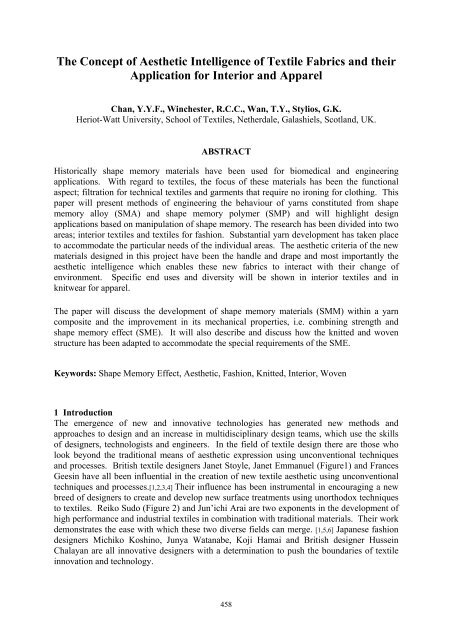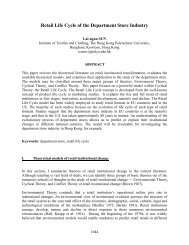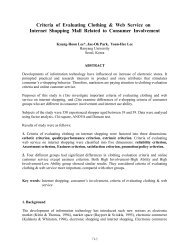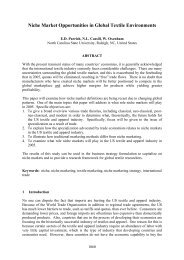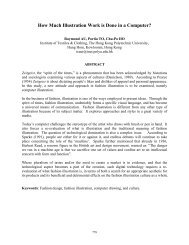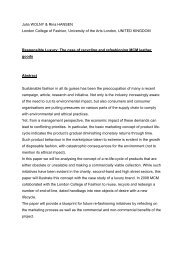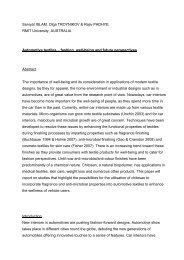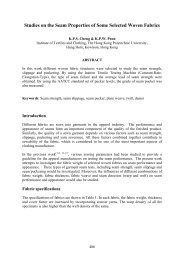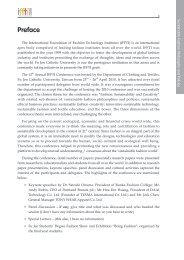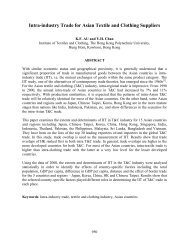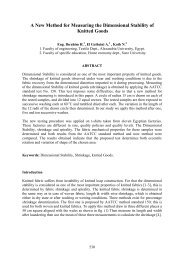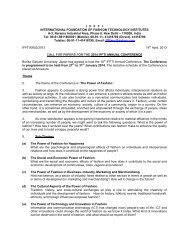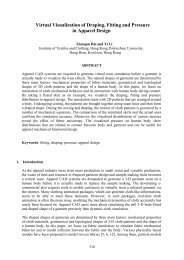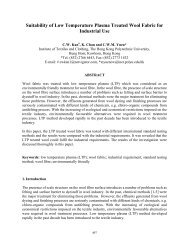The Concept of Aesthetic Intelligence of Textile Fabrics and their ...
The Concept of Aesthetic Intelligence of Textile Fabrics and their ...
The Concept of Aesthetic Intelligence of Textile Fabrics and their ...
You also want an ePaper? Increase the reach of your titles
YUMPU automatically turns print PDFs into web optimized ePapers that Google loves.
<strong>The</strong> <strong>Concept</strong> <strong>of</strong> <strong>Aesthetic</strong> <strong>Intelligence</strong> <strong>of</strong> <strong>Textile</strong> <strong>Fabrics</strong> <strong>and</strong> <strong>their</strong><br />
Application for Interior <strong>and</strong> Apparel<br />
Chan, Y.Y.F., Winchester, R.C.C., Wan, T.Y., Stylios, G.K.<br />
Heriot-Watt University, School <strong>of</strong> <strong>Textile</strong>s, Netherdale, Galashiels, Scotl<strong>and</strong>, UK.<br />
ABSTRACT<br />
Historically shape memory materials have been used for biomedical <strong>and</strong> engineering<br />
applications. With regard to textiles, the focus <strong>of</strong> these materials has been the functional<br />
aspect; filtration for technical textiles <strong>and</strong> garments that require no ironing for clothing. This<br />
paper will present methods <strong>of</strong> engineering the behaviour <strong>of</strong> yarns constituted from shape<br />
memory alloy (SMA) <strong>and</strong> shape memory polymer (SMP) <strong>and</strong> will highlight design<br />
applications based on manipulation <strong>of</strong> shape memory. <strong>The</strong> research has been divided into two<br />
areas; interior textiles <strong>and</strong> textiles for fashion. Substantial yarn development has taken place<br />
to accommodate the particular needs <strong>of</strong> the individual areas. <strong>The</strong> aesthetic criteria <strong>of</strong> the new<br />
materials designed in this project have been the h<strong>and</strong>le <strong>and</strong> drape <strong>and</strong> most importantly the<br />
aesthetic intelligence which enables these new fabrics to interact with <strong>their</strong> change <strong>of</strong><br />
environment. Specific end uses <strong>and</strong> diversity will be shown in interior textiles <strong>and</strong> in<br />
knitwear for apparel.<br />
<strong>The</strong> paper will discuss the development <strong>of</strong> shape memory materials (SMM) within a yarn<br />
composite <strong>and</strong> the improvement in its mechanical properties, i.e. combining strength <strong>and</strong><br />
shape memory effect (SME). It will also describe <strong>and</strong> discuss how the knitted <strong>and</strong> woven<br />
structure has been adapted to accommodate the special requirements <strong>of</strong> the SME.<br />
Keywords: Shape Memory Effect, <strong>Aesthetic</strong>, Fashion, Knitted, Interior, Woven<br />
1 Introduction<br />
<strong>The</strong> emergence <strong>of</strong> new <strong>and</strong> innovative technologies has generated new methods <strong>and</strong><br />
approaches to design <strong>and</strong> an increase in multidisciplinary design teams, which use the skills<br />
<strong>of</strong> designers, technologists <strong>and</strong> engineers. In the field <strong>of</strong> textile design there are those who<br />
look beyond the traditional means <strong>of</strong> aesthetic expression using unconventional techniques<br />
<strong>and</strong> processes. British textile designers Janet Stoyle, Janet Emmanuel (Figure1) <strong>and</strong> Frances<br />
Geesin have all been influential in the creation <strong>of</strong> new textile aesthetic using unconventional<br />
techniques <strong>and</strong> processes.[1,2,3,4] <strong>The</strong>ir influence has been instrumental in encouraging a new<br />
breed <strong>of</strong> designers to create <strong>and</strong> develop new surface treatments using unorthodox techniques<br />
to textiles. Reiko Sudo (Figure 2) <strong>and</strong> Jun’ichi Arai are two exponents in the development <strong>of</strong><br />
high performance <strong>and</strong> industrial textiles in combination with traditional materials. <strong>The</strong>ir work<br />
demonstrates the ease with which these two diverse fields can merge. [1,5,6] Japanese fashion<br />
designers Michiko Koshino, Junya Watanabe, Koji Hamai <strong>and</strong> British designer Hussein<br />
Chalayan are all innovative designers with a determination to push the boundaries <strong>of</strong> textile<br />
innovation <strong>and</strong> technology.<br />
458
Figure 1 Janet Emmanuel (2002) Figure 2 Reiko Sudo, Stainless Steel Emboss (1992)<br />
Acoustic Shadows, Industrial Woven <strong>and</strong> splatter-plated polyester<br />
non-woven, paper, string <strong>and</strong> <strong>Textile</strong>s <strong>and</strong> new Technology 2010<br />
ultrasound, <strong>The</strong> <strong>Textile</strong> Book<br />
<strong>The</strong> changing life <strong>of</strong> the consumer has dem<strong>and</strong>ed improvements <strong>of</strong> technology to enhance<br />
<strong>their</strong> lifestyles. Technology is becoming less invasive <strong>and</strong> with an increased emphasis on its<br />
aesthetic appeal. Within in the world <strong>of</strong> textile research, conductive fibre technology has<br />
become an integral part <strong>of</strong> the development <strong>of</strong> wearable technology. Companies including<br />
Philips Design, WRONZ in collaboration with Paratech Ltd <strong>and</strong> Starlab are all involved in the<br />
development <strong>of</strong> this area.[7,8,9,10] Other companies such as Toyobo, Toray Group USA,<br />
Welbeck, <strong>and</strong> DuPont are all developing advanced fibre technology. [11,12,13,14]<br />
<strong>The</strong>se garments <strong>and</strong> textiles are still dominated by technology <strong>and</strong> function. <strong>The</strong> design <strong>and</strong><br />
aesthetics are created around these factors. It has always been the case however, that the<br />
overriding appeal <strong>of</strong> a garment or textile has been its aesthetics. Despite the efforts <strong>of</strong> those<br />
designers working with unconventional techniques, design work based on smart or intelligent<br />
textiles using SMM is scarce <strong>and</strong> only used for technical solutions. Our research is based on<br />
how we can engineer new textile designs by manipulating shape memory technology. <strong>The</strong><br />
research involves two str<strong>and</strong>s, the first, knitted textile for fashion; the second, woven interior<br />
textiles specifically for window treatments <strong>and</strong> partitions <strong>and</strong> these will be elaborated on, later<br />
in the paper.<br />
SMM’s have been developed principally for biomedical <strong>and</strong> engineering applications. <strong>The</strong>se<br />
applications include micro-actuators, vascular stents, orthodontic archwires <strong>and</strong> aerospace.<br />
More recent developments include diverse areas such as eyewear, underwire bras, golf clubs,<br />
robotics <strong>and</strong> sculpture.<br />
Mitsubishi Heavy Industries have produced <strong>their</strong> own range <strong>of</strong> active sports clothing called<br />
“Diaplex”.[18] This is created by laminating an SMP between two layers <strong>of</strong> fabric, creating a<br />
membrane. It can simultaneously be waterpro<strong>of</strong>, windpro<strong>of</strong> <strong>and</strong> breathable. <strong>The</strong> membrane<br />
works by applying the Micro-Brownian motion, which is a thermal vibration.[19,20] <strong>The</strong><br />
Diaplex membrane is stimulated when the temperature rises above the predetermined<br />
temperature. Due to the Micro-Brownian motion, micro-pores are created in the polymer<br />
membrane, which allows perspiration <strong>and</strong> body heat to escape.<br />
459
Corpo Nove, a fashion house in Florence, Italy, have designed <strong>and</strong> produced a shirt using<br />
SMA fibres.[21,22] <strong>The</strong>se fibres are interspersed with nylon when the fabric is woven. <strong>The</strong><br />
novelty <strong>of</strong> the shape memory shirt is that it is programmed to shorten its sleeves when the<br />
temperature increases. <strong>The</strong> shirt does not require ironing, as heat will stimulate the SMA<br />
fibres, enabling the shirt to return to its original shape.<br />
2 Shape Memory Materials <strong>and</strong> <strong>their</strong> Principles<br />
Shape memory materials (SMM) are adaptive temperature sensitive materials, which have the<br />
ability to return to a pre-programmed shape when stimulated.[15,16] <strong>The</strong>re are a variety <strong>of</strong><br />
stimuli that can be applied such as an electric current, solar energy, magnetic energy <strong>and</strong> heat<br />
generated by changes in body temperature. <strong>The</strong>se materials come in two forms, shape<br />
memory alloy (SMA) <strong>and</strong> shape memory polymer (SMP). SMA can exhibit a strain <strong>of</strong> up to<br />
8%, whereas SMP can extend up to 200%. <strong>The</strong> recovery <strong>of</strong> SMA is 100% however, SMP<br />
does not always fully recover its original form.<br />
<strong>The</strong> crystal lattice structure <strong>of</strong> the SMA is the mechanical property that allows the shape<br />
memory effect (SME) to take place. This is known as the martensitic phase transformation<br />
(MPT), (Figure 3). This consists <strong>of</strong> two stable phases, a low temperature phase called<br />
martensite <strong>and</strong> a high temperature phase called austenite. During the martensite phase the<br />
material can be deformed into its prescribed shape however, it can recover to its original<br />
shape by the reverse transformation upon heating to a critical temperature called the reverse<br />
transformation temperature (A s ).<br />
Parent phase Martensite Parent phase<br />
Figure 3 Martensitic Phase Transformation<br />
Through a repeated process <strong>of</strong> heating <strong>and</strong> rapid quenching, the relationship between the two<br />
different crystal structures is set. Once the process has been completed, the SMA will retain<br />
its new shape. During martensite the SMA can be deformed or re-shaped but it will always<br />
return to original shape when heated. SMA also exhibits superelasticity (SE), which is a<br />
pseudoelasticity that occurs above A s . Deformation occurs when a small force or load is<br />
applied. When the force is unloaded, the material will automatically return to its original form.<br />
Superelasticity occurs without assistance <strong>of</strong> heat.<br />
<strong>The</strong>re is a range <strong>of</strong> different alloy compounds that exhibit the SME, these include nickeltitanium-copper<br />
(Ni-Ti-Cu), copper-zinc-aluminium (Cu-Zn-Al). However, the most<br />
extensively used is nickel-titanium (Ni-Ti) compound. [17] This is due to its superiority in<br />
terms <strong>of</strong> transformation, recovery <strong>and</strong> biocompatibility. NiTi alloy has been selected for the<br />
development <strong>of</strong> this research.<br />
3 Engineering <strong>Aesthetic</strong> <strong>Intelligence</strong> into <strong>Textile</strong>s<br />
Design inspiration traditionally comes from a visual motif, comprising colour, form, texture<br />
<strong>and</strong> pattern. In this research however, the inspiration comes from the SMM <strong>and</strong> its<br />
460
mechanical properties. This has led to an intensive process in the development <strong>of</strong> the SMM’s,<br />
to allow the realisation <strong>of</strong> the designs to take place.<br />
3.1 Preliminary Experiments with Spinning <strong>of</strong> Metal Wire<br />
Conventional wires with similar properties to SMA in diameters between 0.l0 – 0.30mm were<br />
experimented in development <strong>of</strong> new yarns. <strong>The</strong> development <strong>of</strong> the yarns was two-fold. <strong>The</strong><br />
first was to gain a technical awareness <strong>of</strong> how successfully the wire could be spun. <strong>The</strong><br />
second was to develop aesthetic qualities within the yarn composite.<br />
To produce yarn on the Gemmel <strong>and</strong> Dunsmore Fancy Wrap Spinner, a series <strong>of</strong> draft rollers<br />
feed the yarn through the machine whilst simultaneously applying twist or wrap around a core<br />
yarn. Different fancy yarns are created by altering the programme <strong>of</strong> the computer <strong>and</strong> by the<br />
placement <strong>of</strong> the yarns within the roller. At lower twist levels the wire protruded<br />
intermittently to the outside <strong>of</strong> the yarn, rather than remain in the core, producing a yarn that<br />
lacked dimensional stability. Various levels <strong>of</strong> twist were applied to each yarn composite,<br />
until good dimensional stability was achieved.<br />
3.2 Engineering <strong>Aesthetic</strong>s in SMA<br />
Preliminary work prior to the construction <strong>of</strong> yarns involved not only the potential <strong>of</strong> the<br />
SME but also researching various visual motifs. <strong>The</strong>se motifs were instrumental in<br />
determining the colours <strong>and</strong> textures that would be used to enhance the design aesthetic <strong>and</strong> in<br />
the selection <strong>of</strong> yarns to be incorporated into a yarn composite. Varying tex counts were<br />
selected <strong>and</strong> included viscose, Lurex, Tactel, cashmere <strong>and</strong> synthetic <strong>and</strong> natural blends.<br />
In the first developments <strong>of</strong> using SMA as the core, it was decided to develop a simple yarn<br />
construction with four wrapper yarns <strong>and</strong> binder. <strong>The</strong> SMA used was 0.125 mm in diameter<br />
<strong>and</strong> had a bright/polished surface. This surface treatment eliminates imperfections <strong>and</strong><br />
reduces the amount <strong>of</strong> friction that could hinder the spinning, weaving or knitting processes.<br />
<strong>The</strong> first wrapping that came <strong>of</strong>f the machine was very twist lively. This was due to the<br />
springy nature <strong>of</strong> the SMA <strong>and</strong> the level <strong>of</strong> twist in the yarn. <strong>The</strong> h<strong>and</strong>le <strong>of</strong> the yarn was stiff<br />
<strong>and</strong> inflexible. When a length <strong>of</strong> yarn was held up between the h<strong>and</strong>s, it displayed a very high<br />
level <strong>of</strong> twist <strong>and</strong> spiralled around itself. After a few minutes however, there was evidence <strong>of</strong><br />
twist relaxation. On further examination, however, there was evidence <strong>of</strong> the SMA<br />
protruding from the middle <strong>of</strong> the yarn. Further tests using different levels <strong>of</strong> twist reduced<br />
the twist liveliness <strong>and</strong> produced less slippage.<br />
Movement is the fundamental attribute <strong>of</strong> the SME <strong>and</strong> has been utilised to create new <strong>and</strong><br />
dynamic yarn composites. <strong>The</strong> concept <strong>of</strong> reflective light combined with movement has been<br />
instrumental in the creation <strong>of</strong> yarns with an optical effect (Figs. 8,11). From the careful<br />
selection <strong>of</strong> yarns these effects have been used in both a subtle <strong>and</strong> dramatic manner. <strong>The</strong> use<br />
<strong>of</strong> light <strong>and</strong> dark, matt <strong>and</strong> shine <strong>and</strong> the incorporation <strong>of</strong> different levels <strong>of</strong> twist have<br />
achieved these effects. Overfeeding <strong>of</strong> the effect yarns <strong>and</strong> the use <strong>of</strong> textured yarns were<br />
developed to enhance the woven <strong>and</strong> knitted structure (Figures 6,9,13). <strong>The</strong> intended<br />
application <strong>of</strong> these yarns was that they would be concealed within a structure <strong>and</strong> when the<br />
structure opens the texture becomes visible. For some characteristics it is required to have<br />
effect yarns with different tex count <strong>and</strong> the core with different diameters. This produces the<br />
surface textures on the yarn composite (Figures 4,7,12).<br />
461
Figure 4 Chenille Figure 5 Spiral Figure 6 Slub<br />
Figure 7 Gimp Figure 8 Corkscrew Figure 9 Ratiné<br />
Figure 10 Spiral<br />
Figure 11 Optical Spiral<br />
Figure 12 Texture Spiral<br />
Figure 13 Overfeed<br />
As a substitute for SMP in a yarn composite, sp<strong>and</strong>ex was applied. A range <strong>of</strong> yarn<br />
composites has been produced with different diameters <strong>of</strong> sp<strong>and</strong>ex to achieve varying<br />
amounts <strong>of</strong> elasticity. It was important to consider how the SMP would react in a yarn<br />
composite, as sp<strong>and</strong>ex has a different form <strong>of</strong> elasticity to SMP, i.e. sp<strong>and</strong>ex is able to recover<br />
its full shape instantly upon unloading, whereas SMP does not recover its full shape<br />
immediately. Hence, the amount <strong>of</strong> yarn applied <strong>and</strong> the wraps per metre will need to be less<br />
than a yarn composite that consists <strong>of</strong> SMA. If there are less yarns wrapped around the SMP<br />
<strong>and</strong> not highly twisted this will allow the SME to perform. In contrast to applying the SMP<br />
as the core <strong>of</strong> the yarn, it is possible to overfeed the SMP; therefore the SMP would be the<br />
surface effect <strong>of</strong> the yarn composite. <strong>The</strong> SME would be a more visual change to the yarn,<br />
e.g. transforming from straight to spiral <strong>and</strong> not a structural change to a textile when applied.<br />
It is believed that a yarn composite comprising <strong>of</strong> a SMM <strong>and</strong> sp<strong>and</strong>ex would compliment<br />
<strong>and</strong> assist the SME.<br />
462
With respect to the texture <strong>of</strong> the yarn composite, it was observed that separate criteria needed<br />
to be met for fashion <strong>and</strong> interior applications. For knitting it was important to produce a<br />
yarn that had a good h<strong>and</strong>le <strong>and</strong> could be knitted into a textile suitable for clothing. With<br />
regard to the woven structure, the yarn does not have as many limitations as a knit structure.<br />
As the end application is for interior textiles the h<strong>and</strong>le <strong>of</strong> the yarn does not need to be<br />
smooth or light.<br />
3.3 Developments with SMP<br />
At the earlier stages <strong>of</strong> the research attempts were made to extrude SMP to produce a fibre.<br />
However, first experiments showed that the mechanical properties <strong>of</strong> the SMP failed to<br />
produce a competent yarn to be applied for the end applications. <strong>The</strong> extrudant produced<br />
exhibited poor tensile strength <strong>and</strong> had also suffered contamination from moisture. Due to<br />
these factors, it was appropriate to construct the SMP using tapestry for the woven structure<br />
<strong>and</strong> h<strong>and</strong> knitting needle for the knit structure.<br />
For the tapestry technique, a small frame was used applying a simple plain weave structure.<br />
Nylon mon<strong>of</strong>ilament was applied to make the warp, <strong>and</strong> the SMP was applied in the weft. <strong>The</strong><br />
elastic properties became more apparent when stress was applied during the weave process.<br />
<strong>The</strong> fibre interlaced with the nylon mon<strong>of</strong>ilament similar to a conventional yarn, as it was<br />
sufficiently malleable when applied to a plain weave structure (Figure 14).<br />
During the knitting process, the tension applied to the s<strong>of</strong>tened filament lead to it becoming<br />
thinner <strong>and</strong> tightening around the needle. This action made knitting subsequent courses<br />
difficult. It was not possible to insert the needle without causing the loops to over-stretch. If<br />
too much force were applied, the loops would break. <strong>The</strong> resultant fabrics displayed irregular<br />
tension throughout each row (Figure 15). When the samples were left, they would return back<br />
to <strong>their</strong> original shape with a stiff h<strong>and</strong>le.<br />
Figure 14 Tapestry woven SMP<br />
Figure 15 H<strong>and</strong> knitted SMP<br />
To improve the mechanical properties <strong>and</strong> produce a competent fibre it was elected to blend<br />
another polymer with the SMP. It was important that this did not compromise the SME,<br />
though the addition <strong>of</strong> a secondary polymer would improve the tensile strength as well as the<br />
recovery abilities <strong>of</strong> the SMP.<br />
463
A range <strong>of</strong> polymers was selected to blend with the SMP. Samples with a range <strong>of</strong> 5-30% <strong>of</strong><br />
the selected polymer were weighed <strong>and</strong> dried in an oven with the SMP for a prescribed period<br />
<strong>of</strong> time. A Bradford Ram extruder was used to extrude the blends. <strong>The</strong> samples were<br />
extruded at a range <strong>of</strong> temperatures <strong>of</strong> 170-220°C. <strong>The</strong> temperature <strong>of</strong> the Ram extruder was<br />
increased an increment <strong>of</strong> 10°C. During the extrusion process some samples exhibited poor<br />
flow rate, curling at the die orifice <strong>and</strong> intermittent breaking <strong>of</strong> the filament during drawing.<br />
Some blends did not extrude or were not homogeneous.<br />
Tensile strength was tested using a Nene Instrument, M5. On completion <strong>of</strong> the tests it was<br />
possible to eliminate specific polymers blends <strong>and</strong> temperatures as being inappropriate. This<br />
was due to the fact that they produced filament with poor viscosity, uneven cross-section,<br />
poor strength <strong>and</strong> a low yield point (Figure 16). From these results the temperature settings<br />
<strong>and</strong> polymer blends were reviewed.<br />
<strong>The</strong> increment <strong>of</strong> 10°C was reduced to 5°C in order to obtain a more accurate temperature.<br />
<strong>The</strong> ratios <strong>of</strong> the polymer blends were also reviewed. It was decided to develop blends using<br />
5% increment as opposed to 10%, which did not give satisfactory results. <strong>The</strong> second set <strong>of</strong><br />
tests showed significant improvement (Figure 17). When extruded the viscosity <strong>of</strong> the flow<br />
rate was improved <strong>and</strong> enabled the filament to be drawn in continuous lengths. Visually the<br />
extrudant appeared more uniform <strong>and</strong> consistent in surface texture <strong>and</strong> colour.<br />
Figure 16 Tensile strength <strong>of</strong> polymer blend, first<br />
second test<br />
Figure 17 Tensile strength <strong>of</strong> polymer blend, test<br />
4 Implementation <strong>of</strong> <strong>Aesthetic</strong> Attributes in Fabric Design<br />
<strong>The</strong> unique characteristic <strong>of</strong> movement from SMM is integrated into the knit <strong>and</strong> woven<br />
structure to give textiles the ability to react to environmental changes moreover, visually<br />
transform to a prescribed design.<br />
4.1 <strong>The</strong> Woven Structure for Interiors<br />
All samples were produced on a Harris eight-harness table loom. It is essential that when<br />
producing a warp with a wire composite that the tension be applied evenly. When the warp is<br />
transferred on to the loom it is important that the tension is not exceedingly tight or slack, as<br />
this will result in yarn ends breaking during the weaving process.<br />
To achieve a three-dimensional form in relation to the movement <strong>of</strong> the SME, a range <strong>of</strong><br />
conventional wire <strong>and</strong> diameters were woven solely, (Figures 18,19,20). <strong>The</strong> samples were<br />
manipulated to achieve a three-dimensional structure. Each sample simulates a different<br />
movement such as a wave effect, structures shrinking <strong>and</strong> exp<strong>and</strong>ing <strong>and</strong> structures opening<br />
<strong>and</strong> closing. <strong>The</strong> aspiration <strong>of</strong> these samples is to visualise the possibilities <strong>of</strong> motion within<br />
a three-dimensional structure.<br />
464
Figure 18 Wave effect Figure 19 Shrink <strong>and</strong> exp<strong>and</strong> Figure 20 Open <strong>and</strong> close<br />
Exploring open weave structures in consideration <strong>of</strong> the SME developed the woven structure.<br />
This was achieved by adjusting the set <strong>of</strong> the warp, i.e. the number <strong>of</strong> ends per inch, as this<br />
would influence the design <strong>and</strong> performance <strong>of</strong> the SME. In addition, to achieve spaces in the<br />
woven structure gaps were intentionally assembled in a uniform manner in the reed. This<br />
effect was successful as when the weave structure opens it reveals the textured yarn<br />
composites.<br />
Double-weave cloths were also explored to achieve versatile three-dimensional forms. <strong>The</strong><br />
two layers can be joined or separated <strong>and</strong> pockets or tubes can be formed. <strong>The</strong> interchanging<br />
threads from the layers create the innovative designs. <strong>The</strong> SME would be effective as these<br />
layers could transform a flat textile to a three-dimensional textile. Figure 21 shows a doubleweave<br />
sample constructed <strong>of</strong> three-dimensional tubes in a form <strong>of</strong> pleats. When the SMM is<br />
stimulated <strong>and</strong> the martensitic phase is activated, these pleated tubes close, hence shrinking<br />
the textiles. When the temperature returns back to the ambient temperature the textile returns<br />
to its parent shape. <strong>The</strong> sample shown in Figure 22 exhibits how an over-fed SMP yarn<br />
could be applied on the surface <strong>of</strong> a woven textile woven textile. This characteristic has been<br />
applied in combination with a double-cloth structure, allowing two effects to perform when<br />
stimulated. Figure 23 is using double-cloth principles, sections <strong>of</strong> the top cloth are<br />
interchanging on both sides, <strong>and</strong> this is where the SMM would be applied.<br />
465
Figure 21 Concertina Figure 22 Surface effect Figure 23 Interchanging sections<br />
<strong>The</strong> interchanging sections become a raised rounded form when stimulated. <strong>The</strong> double-cloth<br />
technique allows the design to be visually creative on both sides <strong>of</strong> the textiles. This<br />
characteristic would be particularly beneficial for interior applications.<br />
In consideration for SMP the woven structure was tackled a different approach (Figure 24).<br />
SMP is a s<strong>of</strong>ter material in comparison to SMA; therefore the h<strong>and</strong>le <strong>of</strong> the fabric is lighter<br />
<strong>and</strong> will have adequate drape qualities. Sp<strong>and</strong>ex has similar properties to SMP. Within the<br />
yarn composite it was used created the dynamic movement <strong>of</strong> the yarn <strong>and</strong> was taken into<br />
consideration when incorporated into the woven structure. This influenced the other yarns<br />
used in the woven structure, as bulkier yarns were used to enhance the surface effect from the<br />
sp<strong>and</strong>ex composite. It is believed that this principle will enrich the SME in the woven<br />
structure when SMP is applied.<br />
Figure 24 Woven sample simulating the effect <strong>of</strong> SMP<br />
466
Experimenting with the samples while on the loom produced effective <strong>and</strong> creative results as<br />
the yarn composites could be exploited to <strong>their</strong> full potential. To achieve different surface<br />
effects the tension <strong>of</strong> the warp was adjusted. As the samples could be manipulated whilst still<br />
on the loom, the effect <strong>of</strong> the wire could be observed therefore, encouraging the design to<br />
illuminate further.<br />
As the fundamental consideration <strong>of</strong> the woven textile is the aesthetic, the application <strong>of</strong> the<br />
shape memory textile is one where it will not be extensively h<strong>and</strong>led, i.e. cushions, rugs, <strong>and</strong><br />
s<strong>of</strong>as. Suitable applications would be window treatments, partitions or wall hangings.<br />
<strong>Textile</strong>s having the ability to alter in shape will have a significant <strong>and</strong> stimulating effect to an<br />
interior space. Utilising a shape memory partition or wall hanging can convert the function<br />
<strong>and</strong> essence <strong>of</strong> the interior from a formal workplace to a relaxed, calm <strong>and</strong> social atmosphere.<br />
Visually the woven structure transmutes exposing the yarn composites <strong>and</strong> a dynamic design.<br />
<strong>The</strong>se applications would be on dem<strong>and</strong>, as an electric current would be applied to invigorate<br />
the textile. Furthermore, the same application can also participate in the environmental<br />
conditions <strong>of</strong> a room when provoked by temperature. Consequently, if the temperature in a<br />
room was below ambient the woven structure would evolve into a “closed” form <strong>and</strong> perform<br />
as an insulator, allowing the heat to remain in the room. In contrast, if the temperature were<br />
above ambient, the shape memory structure would ‘open’ to allow air to circulate freely<br />
around the space keeping the room cool. As SMM can be stimulated by sunlight, this feature<br />
can be exploited when applied for window treatments, thus adapting to its environment.<br />
When a shape memory window treatment is programmed to be sensitive to sunlight the<br />
woven structure opens to allow light to enter the room during the day <strong>and</strong> close when night<br />
falls. Or/in addition, the woven structure was programmed to close to reduce glare in the<br />
room if excessive sunlight was applied onto the textiles.<br />
<strong>The</strong>se textiles would be consummate when part <strong>of</strong> an intelligent network in an interior space.<br />
Shape memory textiles <strong>of</strong>fers smart interiors <strong>and</strong> st<strong>and</strong>ard interiors additional benefits, such<br />
as performing as a decorative feature as well as a functional textile. Unlike conventional<br />
static textiles, smart textiles have the competence to react <strong>and</strong> adjust to the environmental<br />
conditions along with modify the function <strong>of</strong> the space whilst being aesthetically pleasing.<br />
4.2 <strong>The</strong> Knit Structure for Fashion Apparel<br />
An in-depth underst<strong>and</strong>ing <strong>of</strong> the technical aspects <strong>and</strong> requirements <strong>of</strong> the knitting process<br />
would need to take precedence in order not to compromise the design. Flyer pay-<strong>of</strong>f is the<br />
major contributory factor to the problem <strong>of</strong> knitting with wire. It occurs when the yarn is<br />
drawn <strong>of</strong>f the supply package <strong>and</strong> threaded into the knitting machine <strong>and</strong> continues to be a<br />
problem throughout the knitting process. Its causes are tw<strong>of</strong>old; the first, is wires ability to<br />
hold shape; the second is the “stick/slip/stick” phenomenon. As the wire is drawn from the<br />
package, it maintains the circular shape <strong>of</strong> that package. This spiral configuration is only<br />
partly drawn out as the wire goes through the tension feeds <strong>of</strong> the machine.<br />
<strong>The</strong> “stick/slip/stick” phenomenon, is when the wire intermittently sticks as it is delivered<br />
from the package, through the tension feeds, consequently, the tension in the wire increases.<br />
<strong>The</strong> force applied to the yarn as the cam carriage is taken across the needle bed produces a<br />
sudden release <strong>of</strong> tension. This release results in the wire springing from the package, in long<br />
spiral lengths. <strong>The</strong> yarn twists on itself, causing kinks to develop along the length <strong>of</strong> the wire.<br />
As a result, obtaining an even tension throughout the knitting process is difficult. Flyer pay-<br />
467
<strong>of</strong>f is instrumental in the creation <strong>of</strong> other knitting problems including, uneven tension,<br />
knock-over, take down <strong>and</strong> the ability to knit a complete course.<br />
Variation <strong>of</strong> structure <strong>and</strong> technique <strong>and</strong> the philosophy <strong>of</strong> craft <strong>and</strong> technology working in<br />
t<strong>and</strong>em were fundamental to the evolution <strong>of</strong> the design aesthetic. Consequently, h<strong>and</strong><br />
knitting <strong>and</strong> the use <strong>of</strong> two different knitting machines was employed. Each system<br />
contributes its own unique stitch <strong>and</strong> patterning capabilities <strong>and</strong> allows a greater variety <strong>of</strong><br />
yarn types to be used. <strong>The</strong> machines used were a 7 gauge Dubied V-bed flat knitting<br />
machine <strong>and</strong> a Knitmaster Model 321 domestic knitting machine.<br />
<strong>The</strong> first machine developments were small sample pieces <strong>of</strong> 11cm square, constructed in<br />
single bed plain knit. It was evident from the h<strong>and</strong>le <strong>and</strong> drape <strong>of</strong> the fabric produced, that<br />
they would not be suitable for whole garment application. When removed from the machine,<br />
the top <strong>and</strong> bottom <strong>of</strong> the samples would roll to the middle on the face side, forming a tight<br />
cylindrical fabric. <strong>The</strong> fabric remained in this tight form, even after attempts were made to<br />
flatten the fabric using a steam iron. From these results, it was considered that the most<br />
appropriate method <strong>of</strong> introducing SMA to the knitted structure would only be in selected<br />
areas <strong>of</strong> a fabric.<br />
A principle <strong>of</strong> the research is to redirect the aesthetic from something static to something<br />
active, to produce “living” fabrics that evolve; to present the industrial as sensual <strong>and</strong> tactile.<br />
<strong>The</strong> SME creates a dual, decorative fabric that can exhibits different aesthetic characteristics<br />
within the same cloth. Three dimensional <strong>and</strong> sculptural fabrics have been developed that<br />
enhance these concepts. Figure 25 is a fabric that when the SMM is stimulated, it<br />
metamorphoses into a cloth with a raised surface pattern. With Figure 26, a 3-dimensional<br />
pattern already exists in the form <strong>of</strong> half-moon structures. In this case, when the SME is<br />
stimulated, the half-moon structures evolve into a circular form.<br />
Figure 25 Pattern created using Figure 26 Pattern created using<br />
a Knitmaster 321 a Knitmaster 321.<br />
With 3-dimensional structures the SME could be a spontaneous or gradual change with a<br />
single structure containing both dominant <strong>and</strong> subordinate effects. It would be possible to<br />
capitalise on these concepts as in Figure 28. This illustrates a fabric that has been designed<br />
with consideration to the placement <strong>of</strong> the SMM within the structure together with materials<br />
that respond at different rates, thus giving a fabric that has the ability to move around the<br />
468
ody. Figure 27 relates to the concept <strong>of</strong> dual colour or texture being created in one fabric.<br />
<strong>The</strong> SME causes the structure to open, revealing a second colour or texture beneath the<br />
surface.<br />
Figure 27 Pattern created using Figure 28 Pattern created using<br />
a Dubied V-bed. a Knitmaster 321.<br />
Figures 29 <strong>and</strong> 30 illustrate how the SME would be placed within the selected areas <strong>of</strong> a<br />
garment. <strong>The</strong> inclusion <strong>of</strong> SMM’s into the knitted structure introduces a new garment form.<br />
This evolution in form, changing the garment from static to active <strong>and</strong> presents dimensional<br />
changes that add value to the garment.<br />
Figure 29 3-dimensional textile concept.<br />
Figure 30 3-dimensional textile concept.<br />
Through the decorative process, it is possible to produce a textile with particular functional<br />
attributes. <strong>The</strong> textile would not only evolve into another aesthetic, the SME would<br />
simultaneously produce structures that open <strong>and</strong> close, depending upon the environmental<br />
469
conditions <strong>and</strong>/or the body temperature <strong>of</strong> the wearer. A single fabric could alter from<br />
compact <strong>and</strong> warm to open <strong>and</strong> cool. This combination gives a high-performance textile with<br />
decorative characteristics.<br />
Although when designing a fashion textile or garment comfort <strong>and</strong> function are significant<br />
aspects, primary drivers attributed by the consumer to a garment or textile are style <strong>and</strong><br />
aesthetic quality. <strong>Textile</strong>s <strong>and</strong> clothing are moving into new areas <strong>of</strong> function, <strong>their</strong> rôle as a<br />
means <strong>of</strong> decoration, adornment or implied status however, is still a relevant factor which<br />
deserves continued attention. An important requirement from the consumer point-<strong>of</strong>-view is<br />
that clothing enhances the body <strong>and</strong> presents the required image.<br />
5 Conclusions <strong>and</strong> Future Research<br />
This research reflects the increasing significance <strong>of</strong> technological innovation using SMM in<br />
textiles <strong>and</strong> the importance <strong>of</strong> capitalising on the aesthetic potential that can be gained from<br />
these innovations. To accommodate the particular needs for apparel <strong>and</strong> interior textiles,<br />
intensive fibre, yarn <strong>and</strong> fabric development has taken place. A variety <strong>of</strong> yarn composites<br />
based on SMA <strong>and</strong> SMP with a range <strong>of</strong> characteristics have been produced. <strong>The</strong>se were<br />
taken forward into fabric form where further engineering requirements were realised.<br />
<strong>The</strong> mechanical properties <strong>of</strong> the SMP have been improved, this will enhance the aesthetic<br />
intelligence when applied to specific end uses. <strong>The</strong> continued improvement <strong>of</strong> the mechanical<br />
properties for SMM will enable a broader range <strong>of</strong> textile design <strong>and</strong> application. <strong>The</strong><br />
properties <strong>of</strong> SMM provide a dynamic <strong>and</strong> stimulating approach to design. <strong>The</strong>ir potential<br />
has yet to be fully explored <strong>and</strong> will inevitably lead to unique <strong>and</strong> exciting textile design.<br />
Acknowledgements<br />
<strong>The</strong> authors wish to thank Andrew McCullough <strong>and</strong> Stewart Wallace for <strong>their</strong> invaluable<br />
assistance <strong>and</strong> expertise. Andrew’s extensive knowledge <strong>and</strong> skill with regard to yarn<br />
production <strong>and</strong> Stewart for his contribution in the field <strong>of</strong> polymer science.<br />
References<br />
1 Braddock, S. E., O’Mahony, M. (1999) Techno <strong>Textile</strong>s: Revolutionary <strong>Fabrics</strong> for Fashion <strong>and</strong> Design, 2 nd .<br />
Ed. London, Thames <strong>and</strong> Hudson<br />
2 Frances Geesin, (2002) Lecture, 15 th May 2002, Knitwear/Electroplated <strong>Textile</strong>s, Heriot Watt University.<br />
3 Gale, C. <strong>and</strong> Caur, J. (2002) <strong>The</strong> <strong>Textile</strong> Book 1 st Edition Oxford, Berg.<br />
4 Emmanuel, J. (2001) Conference, 21 st February 2001, Twist in the Yarn, Making the Visible Invisible,<br />
Manchester Metropolitan University.<br />
5 Braddock, S. & O’Mahony, M. (1994) <strong>Textile</strong>s <strong>and</strong> New Technology: 2010 Artemis Limited, London.<br />
6 McCarty, C., McQuaid, M. (1998) Structure <strong>and</strong> Surface: Contemporary Japanese <strong>Textile</strong>s, 1 st Ed. New York:<br />
<strong>The</strong> Museum <strong>of</strong> Modern Art<br />
7 Philips Research http://www.research.philips.com<br />
8 Starlab Deep Future http://www.starlab.org<br />
9 Fisher,G. Twenty-First Century <strong>Fabrics</strong>, S<strong>of</strong>t Switching for Wearable Electronics, <strong>Textile</strong> Horizons, Sept-Oct.<br />
2000 pp17-18<br />
10 Hum, A.P.J. Fabric Area Network – An Ubiquitous Wireless Communications Infrastructure for Intelligent<br />
Wear, 4 th World Multi-Conference on Systemics, Cybernetics <strong>and</strong> Infarmatics, 23-26 July 2000 pp.61-65<br />
11 Toray http://www.toray.com<br />
12 Toyobo http://www.toyobo.co.jp<br />
13<br />
Welbeck http://www.welbeck-fabrics.co.uk<br />
14 Shah, D. (2000) Conference, 21 st January 2000, What Future for <strong>Textile</strong>s, Canary Wharf, London.<br />
15 Otsuka, K & Wayman, C.M. (Eds.) (1998) Shape Memory Materials, Cambridge University Press, Cambridge<br />
16 Van Humbeeck, J. (1999) Non Medical Applications <strong>of</strong> Shape Memory Alloys, Material Science <strong>and</strong><br />
Engineering, A273-275, 1999, pp.134-148.<br />
470
17<br />
Hodgson, D.E. <strong>and</strong> Biermann, R.J., (1999) Shape Memory Alloys, Shape Memory Applications Inc. Santa<br />
Clara, California.<br />
18 Mitsubishi Heavy Industries, Ltd. http://www.diaplex.com<br />
19 Hayashi, S., Kondo, S. <strong>and</strong> Giordano, C. (1994) Properties <strong>and</strong> Applications <strong>of</strong> Polyurethane-Series Shape<br />
Memory Polymer, Technical Papers <strong>of</strong> the Annual Technical Conference: Society <strong>of</strong> Plastic Engineers, 1994,<br />
V52/2, pp.1998-2001.<br />
20 Kobayashi, K., Hayashi, S. Woven Fabric made <strong>of</strong> Shape Memory Polymer, US5128197, 7 th July 1992.<br />
21 Clowes, S. (2002) Smart Shirt Rolls up its Sleeves, http://www.news.bbc.co.uk<br />
22 Corpo Nove, http://www.corponove.it<br />
471


